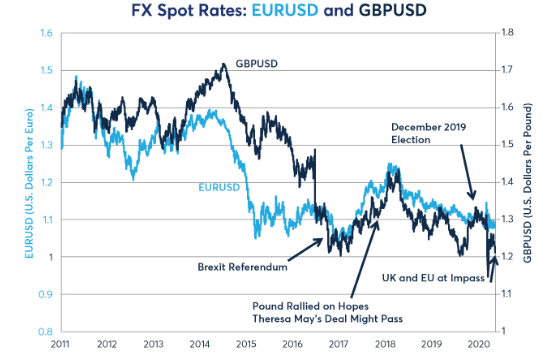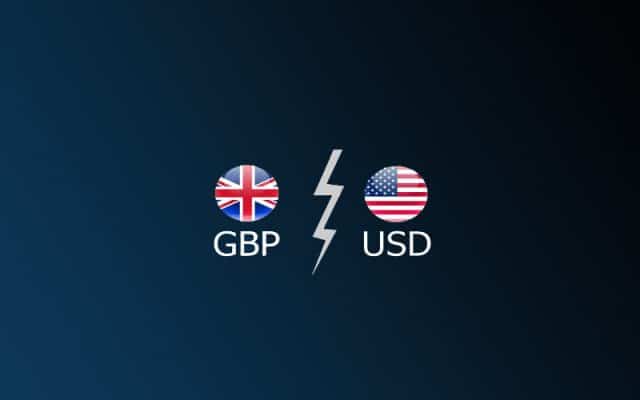GBP/USD Introduction
The GBP/USD pair, which consists of the Great Britain Pound and the U.S. Dollar, is a major currency pair with a lot of history. Trade between the two currencies has been going on for ages, which makes it impossible to find a relative value to the pound, apart from its Dollar exchange rate. The base currency of this pair is the pound and hence, the price is quoted as 1:1.30, where the US Dollar is the 1.30. When the dollar rises, its trending graph will be falling. The pair is colloquially called the “Cable” because of its history. It got its name from the old method of using the Atlantic Cable to transmit prices across the ocean floor in the past.
The GBP/USD pair is especially attractive for day traders as it tends to break strongly in either one way or the other. However, traders trading this pair have to catch up on the news from the eastern session as well. The gold standard has historically governed the two currency’s forex rates. In the early 1970s, the modern concept of the GBP/USD exchange began, replacing existing floating rates for the two currencies.
What Moves GBP/USD
There are different macroeconomic factors that are responsible for moving the GBP/USD exchange rate.
- Interest Rates Differentials: the GBP/USD rises when interest rates in the UK increase more than that in the US.
- Inflation differentials: When inflation in the UK is consistently lower than that in the US, the GBP/USD rises in value. However, in a mild inflation environment, traders can expect a future hike in interest rates by the FED if there’s an inflation increase.
- Public Finance Sustainability: When the public deficit/debt rises in the US more than that if the UK, the GBP/USD pair tends to rise.
- Growth: When the UK GDP grows at an increased rate than the US GDP, the GBP/USD pair rises.
- Labor Market Conditions: The GBP/USD pair tends to rise if the unemployment rate in the UK becomes lower than that in the U.S.
Bank of England
The monetary policy efforts of the Bank of England have a substantial effect on the value of the pound greatly, especially when it changes interest rate and money supply. The Bank of England published its Monetary Policy Report for January 2020 which also includes BOE’s inflation report and information on interest rates.
- Interest rate Decision: The BOE sets interest rates to ensure inflation returns to their pre-set 2% target sustainability, and influence spending in the country’s economy. The BOE has thus decided to keep interest rates at 0.75%
- Inflation: According to the Inflation Report, the inflation is currently below the target of 2%. This is large because of lower gas and oil prices, which in turn has reduced utility bills. Other factors that may have contributed to this situation may be the slower rate of growth experienced by the economy.
The Bank of England has stated that they may need to lower interest rates to ensure that they return to their target sustainably of 2% inflation. A modest rise in interest rates may be applied if the UK economy recovers, with upward pressure building on prices.
UK’s Financials
In May 2020, the UK government borrowed a record £55 billion, making it the single highest borrowed amount since 1993. The public debt right now in the UK has increased to £1.95 trillion, which makes it 100.9% of the GDP.
The Trade Balance has a direct influence on currency exchange rates. It follows the economics of supply and demand, which dictate that prices rise and currencies appreciate in value. The trade balance report comes on a monthly basis. The current account surplus, which shows how much of export and import a country does, effects currency pairs. In this case, a current account surplus for the US would mean a growth of the USD compared to the UK and vice versa.
UK, EU, US Economical Data
- GDP Growth: The best variable to measure the wellness and health of a country’s economy. Higher GDP growth rates suggest higher yields, which can attract international investors. The demand for that particular country’s currency increases as investors need more of that currency to buy goods, services from the country. When the GDP of the UK grows more than the GDP of the US, the GB/USD pair increases in value.
- Labor Market: Another variable to measure the wellness of an economy is the soundness of its labor market. Some of the parameters with which one evaluates the conditions of the labor market are the unemployment rate, number of unemployment, payrolls. Countries with low unemployment rates usually attract investors. The GBP/USD pair increases in value if the US News Events and Data releases indicate that the unemployment rate in the US is higher than that of the UK.
- Inflation: A lower inflation rate can drive the value of that nation’s currency. Countries that experience higher inflation have lower currency values than others. Higher interest rates usually accompany a high inflation rate. However, a mild increase in inflation when the inflation rate is not particularly high, indicates that the central bank can hike interest rates in the future. This can entice international investors to flock towards domestic stocks and bonds.
- Consumer Price Index: The Consumer Price Index, which the Office for National Statistics of the UK releases, represents the cost of living in the UK, and a key indicator to measure inflation. A high and low CPI reading can mean bullish or bearish for the GBP respectively.
Brexit
The US Dollar and GBP Exchange Rate has been impacted by Brexit. However, many analysts believe that sterling has a chance to rebound to previous highs. There are others who believe that the pair will sustain this suppressed price.
The British pound has always rallied when the UK moved towards integrating deeper with Europe. The opposite happens when the UK moves towards a no-deal Brexit. Since the Brexit negotiations between the EU and UK have stalled, the GBP has slid 4.5% versus the USD and 3% vs the EUR.

The Conclusion
The GBP/USD is especially for Day traders. The ideal time for trading this pair is between 12:00 to 15:00 GMT or 08:00 to 10:00 GMT. The volatility of the pair changes over time, with the average volatility increasing to 100 pip per day in some cases. Overall, the main research which traders should conduct is the potential market movements that are triggered by favorable or unfavorable economic data released by the United States or Great Britain.




